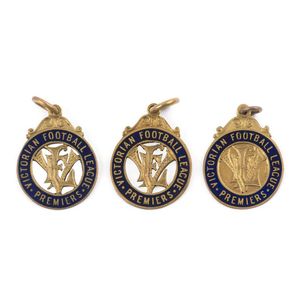1939 Premiership Medal won by Percy Beames
The 1939 Premiership medal won by Melbourne Football Club Hall of Fame Inductee Percy Beames. Superb original condition. Percy James Beames (1911 - 2004) had a remarkable career as an Australian rules footballer of the highest calibre with Melbourne Football Club and, remarkably, was also a first-class cricketer at state level for Victoria. He later became a distinguished journalist, covering both sports for Melbourne's the age until 1976. Beames joined Melbourne in 1931 and soon established himself as the club's rover. He was with the club until 1944, having graduated to the positions of Captain and coach in the later years. As school Captain of the Ballarat College football and cricket teams, Beames had played just two games for Golden Point and was suiting up for his third when a committee man informed him that he was off to Melbourne for an interview with the Redlegs. Upon his arrival, the club arranged for Beames to stay in a local boarding house. During his first night there he heard strange noises from adjoining rooms, only to discover in the morning that he was staying in a brothel. The next day he came out of his interview with a job at chairman Joe Blair's Vacuum Oil Company and a promise of more legitimate lodgings. Having never seen a game of VFL football, Beames was a guest in the MCC members pavilion for the game against Footscray. Not sure what he was going to see, Beames came out of the game believing he could easily match it with these players. Two weeks later he kicked four of Melbourne's nine goals in a reserves match against Collingwood and was promoted to the seniors. In the wet he was voted best on ground. Beames was an instant sensation, being voted best on ground on debut and finishing equal 5th in the 1931 Brownlow medal despite only having played 11 games for the year. During the off-season he was seriously injured playing cricket but returned to play 16 games and finished equal 5th in the Brownlow again in 1932. Beames was voted 'Best all around Player' in 1934, and graduated to the Deputy Vice-Captain the next year and Vice-Captain in 1936. He won the 'Most Consistent Player' award in both 1937 and 1938. After his retirement as Melbourne's last playing coach Beames served as Chairman of Selectors in 1945. He also excelled in the summer months as a state cricketer. First selected in 1932, he scored three first class centuries with a top score of 226. He was still in contention to play for Australia when he retired from the game in 1946. Beames was named in the forward pocket of the Melbourne team of the century. In addition to his eight state games he also played twice for VFL representative sides against the VFA: in 1934 and 1936. The 1939 VFL Grand Final was contested between the Melbourne Football Club and Collingwood Football Club, and held at the MCG on 30 September 1939. It was the 43rd annual Grand Final of the Victorian football League, and attended by 78,110 spectators, was won by Melbourne by a margin of 53 points. Beames was equal top scorer with 4 goals and was widely reported to have been the 'Best on the field'. Provenance: The family, by descent.
You must be a subscriber, and be logged in to view price and dealer details.
Subscribe Now to view actual auction price for this item
When you subscribe, you have the option of setting the currency in which to display prices to $Au, $US, $NZ or Stg.
This item has been sold, and the description, image and price are for reference purposes only.
- Victorian Period - The Victorian period of furniture and decorative arts design covers the reign of Queen Victoria from 1837 to 1901. There was not one dominant style of furniture in the Victorian period. Designers used and modified many historical styles such as Gothic, Tudor, Elizabethan, English Rococo, Neoclassical and others, although use of some styles, such as English Rococo and Gothic tended to dominate the furniture manufacture of the period.
The Victorian period was preceded by the Regency and William IV periods, and followed by the Edwardian period, named for Edward VII (1841 ? 1910) who was King of the United Kingdom and the British Dominions and Emperor of India for the brief period from 1901 until his death in 1910.
This item has been included into following indexes:
- AFL/VFL memorabilia, individual players - VFL (Victorian Football League) 284
- AFL/VFL memorabilia, medals - Brownlow medal 111
- AFL/VFL memorabilia, publications - Victorian Football Association (VFA) 71
- AFL/VFL memorabilia, various - Australian Football Hall of Fame 37
- Collingwood Football Club - AFL/VFL medals, badges and membership cards 145
- Footscray Football Club - AFL/VFL medals, badges and membership cards 20
- Melbourne Cricket Club (MCC) - cricket memorabilia, other 217
- Melbourne Football Club - AFL/VFL medals, badges and membership cards 139
- South Melbourne Football Club - AFL/VFL medals, badges and membership cards 153
- Victorian Football Association - medals, badges and membership cards 36
